 |
 |
 |
| |
Incidence of Herpes Zoster in a Large Cohort of Persons Living with HIV - Herpes Zoster Incidence Falling in HIV Group But Still at 1% in 2011-2016
|
| |
| |
Herpes Zoster Incidence Falling in HIV Group But Still at 1% in 2011-2016
IDWeek2017/IDSA, October 4-8, 2017, San Diego
Mark Mascolini
Herpes zoster incidence (the new-detection rate) fell steadily in a US military HIV cohort but still affected 1 in 100 people every year in 2011-2016, more than in the general population [1]. Antiretroviral therapy (ART), higher CD4 count, and older age lowered chances of herpes zoster in this 2954-person study.
Reactivation of latent varicella-zoster virus results in herpes zoster, or shingles, persistent and painful lesions frequently reported in the early years of the HIV epidemic. Herpes zoster incidence has dropped in people with HIV, but they still have a 3- to 5-fold higher incidence than the general population, and reactivation occurs at an earlier age.
A herpes zoster vaccine lowers chances of these eruptions but is not routinely recommended for people with HIV. To inform vaccine advice, US military researchers conducted this study to determine herpes zoster incidence and risk factors in a contemporary HIV population. Data came from the US military HIV Natural History Study, whose participants make study visits every 6 months. This analysis focused on cohort members who contributed data between January 2001 through December 2016. They had at least one follow-up visit during that period, and none of them had a prior diagnosis of herpes zoster. The investigators used a Cox proportional hazards model to determine risk factors for herpes zoster.
The study group included 2954 people, 237 (8%) of whom had a first herpes zoster episode after 2001. At diagnosis these 237 people had a median age of 38.6 years (interquartile range [IQR] 30.8 to 45.8), a median CD4 count of 461 (IQR 333 to 638), and a median viral load of 1900 copies (IQR 50 to 19,580). Most people with herpes zoster, 92%, were men, and 41% were Caucasian. Median time between HIV diagnosis and starting ART stood at 3.2 years (IQR 0.5 to 6.7). Median follow-up for the group was 3.5 years.
Herpes zoster incidence stood at 3.24 cases per 100 person-years before 1996 and fell significantly over the years: 1.9 per 100 in 1996-2000, 1.44 per 100 in 2001-2005, 1.35 per 100 in 2006-2010, and 0.9 per 100 in 2011-2016. (An incidence of 0.9 per 100 person-years means about 1 in every 100 people got diagnosed with shingles every year.)
The multivariate Cox analysis determined that getting a herpes zoster diagnosis was 70% less likely in 2011-2016 than before 1996 (adjusted hazard ratio [aHR] 0.30, 95% confidence interval [CI] 0.12 to 0.76). Every additional year of age lowered shingles risk 7% (aHR 0.93, 95% CI 0.91 to 0.95). Current ART use made a shingles diagnosis 55% less likely (aHR 0.45, 95% CI 0.22 to 0.92). And every 100-cell higher CD4 count before shingles diagnosis lowered the risk 22% (aHR 0.78, 95% CI 0.74 to 0.83). Every additional year between HIV diagnosis and starting ART raised chances of a shingles diagnosis 4% (aHR 1.04, 95% CI 1.01 to 1.08).
The researchers pointed out that most previous work in this area found increasing herpes zoster incidence with older age, while their study identified older age as a protective factor. They noted that exogenous exposure to varicella-zoster virus seems to protect latently infected people, but exogenous exposure is becoming less frequent with availability of the vaccine. Also, only 13% of their cohort was over 50, so their incidence estimates may be less robust in that group.
The investigators noted that even in the most recent years analyzed, herpes zoster incidence remains higher in people with HIV than in an age-matched general population. They observed that most people in this HIV cohort in whom herpes zoster developed were in their 30s or 40s and had relatively high CD4 counts. Because of the continuing herpes zoster burden in people with HIV, the investigators called for studies of the safety and efficacy of the shingles vaccine in people with HIV.
Reference
1. Gilbert L, Wang X, Deiss R, et al. Incidence of herpes zoster in a large cohort of persons living with HIV. IDWeek2017/IDSA. October 4-8, 2017. San Diego. Abstract 585.
---------------------
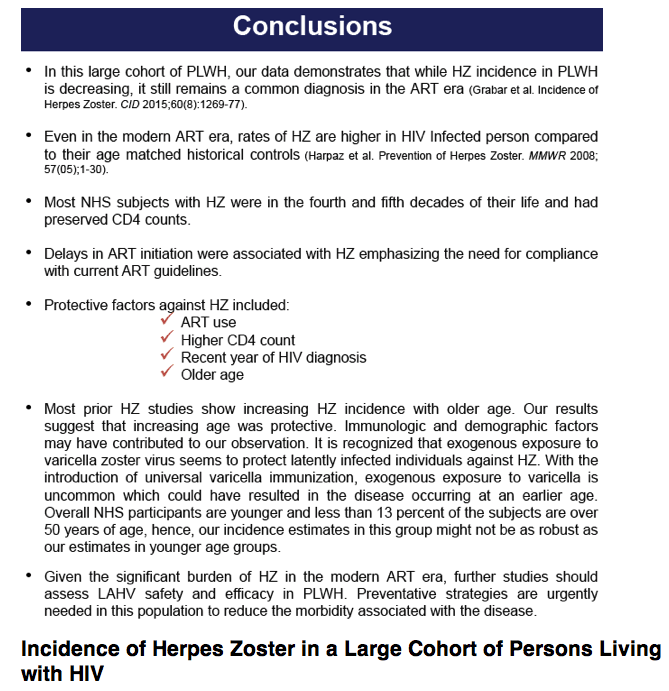
Incidence of Herpes Zoster in a Large Cohort of Persons Living with HIV
Laura Gilbert, MD1; Xun Wang, MS2,3; Robert Deiss, MD2,3,4; Jason Okulicz, MD2,5; Thomas O'Bryan, MD2,3,5; Ryan Maves, MD4; Christina Schofield, MD6; Tomas Ferguson, MD2,7; Timothy Whitman, DO2,8; Brian Agan, MD2,3; Anuradha Ganesan, MD, MPH2,3,8 1U.S. Naval Hospital Guam, Guam; 2Infectious Disease Clinical Research Program, Department of Preventive Medicine and Biostatistics, Uniformed Services University of the Health Sciences, Bethesda, MD, USA; 3The Henry M. Jackson Foundation for the Advancement of Military Medicine, Inc., Bethesda MD, USA; 4Naval Medical Center San Diego, San Diego, California; 5San Antonio Military Medical Center, Fort Sam Houston, TX'; 6Madigan Army Medical Center, Takoma, WA; 7Tripler Army Medical Center, Honolulu, HI; 8Walter Reed National Military Medical Center, Bethesda, MD
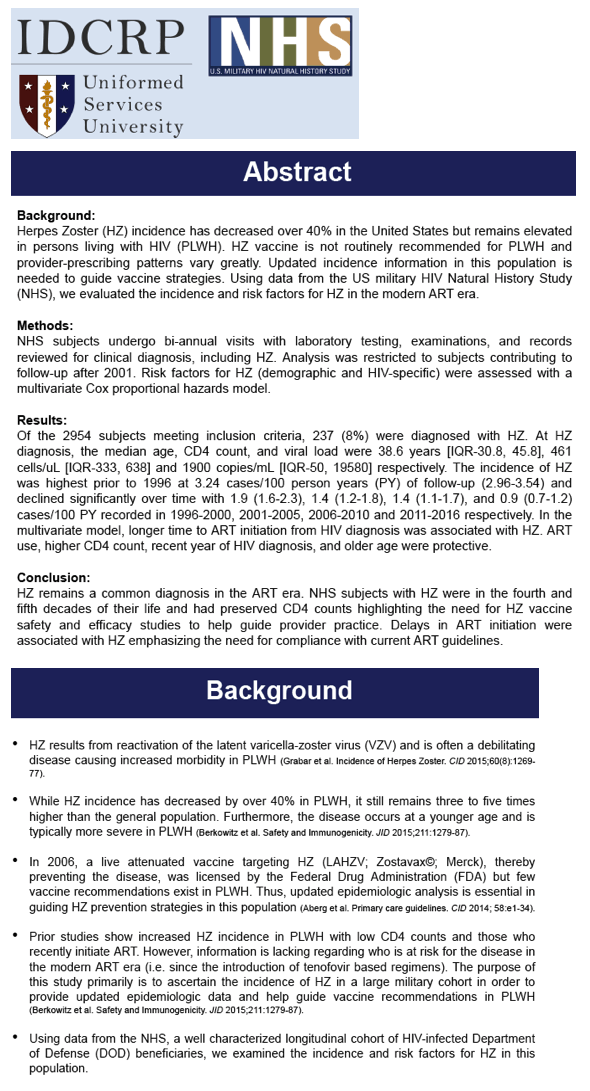
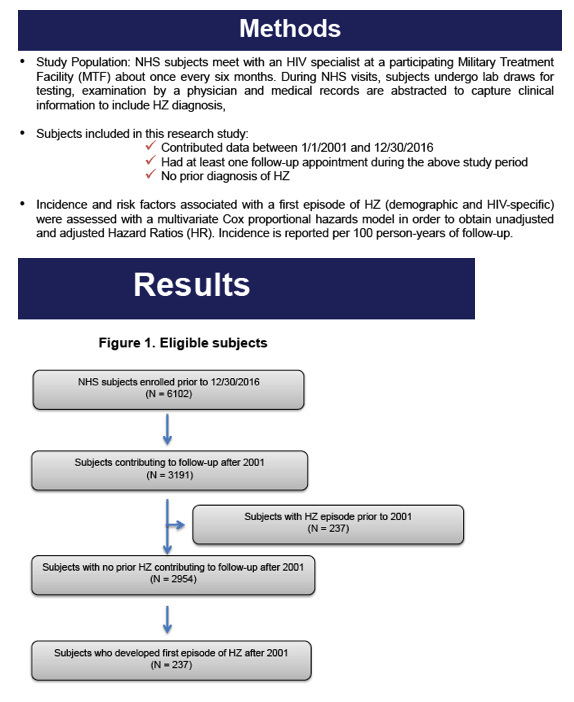
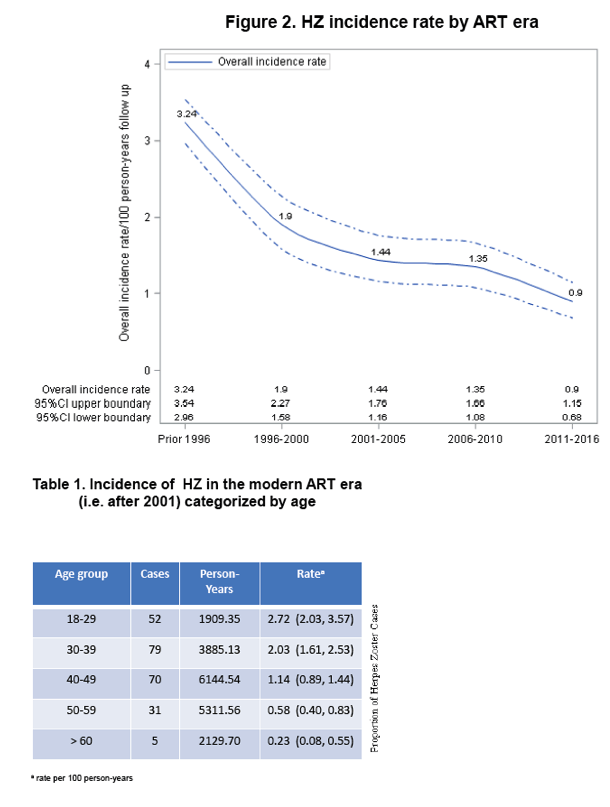

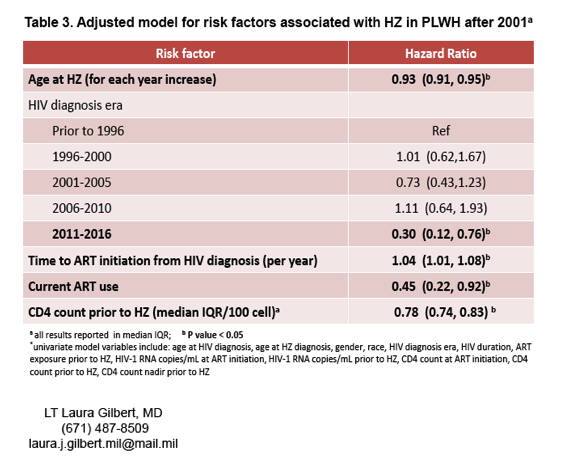
|
| |
|
 |
 |
|
|